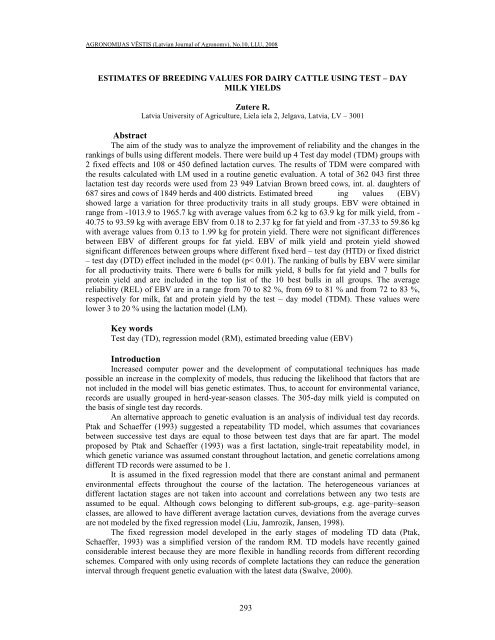AGRONOMIJAS VÄSTIS - Latvijas LauksaimniecÄ«bas universitÄte
AGRONOMIJAS VÄSTIS - Latvijas LauksaimniecÄ«bas universitÄte
AGRONOMIJAS VÄSTIS - Latvijas LauksaimniecÄ«bas universitÄte
- No tags were found...
You also want an ePaper? Increase the reach of your titles
YUMPU automatically turns print PDFs into web optimized ePapers that Google loves.
<strong>AGRONOMIJAS</strong> VĒSTIS (Latvian Journal of Agronomy), No.10, LLU, 2008ESTIMATES OF BREEDING VALUES FOR DAIRY CATTLE USING TEST – DAYMILK YIELDSZutere R.Latvia University of Agriculture, Liela iela 2, Jelgava, Latvia, LV – 3001AbstractThe aim of the study was to analyze the improvement of reliability and the changes in therankings of bulls using different models. There were build up 4 Test day model (TDM) groups with2 fixed effects and 108 or 450 defined lactation curves. The results of TDM were compared withthe results calculated with LM used in a routine genetic evaluation. A total of 362 043 first threelactation test day records were used from 23 949 Latvian Brown breed cows, int. al. daughters of687 sires and cows of 1849 herds and 400 districts. Estimated breed ing values (EBV)showed large a variation for three productivity traits in all study groups. EBV were obtained inrange from -1013.9 to 1965.7 kg with average values from 6.2 kg to 63.9 kg for milk yield, from -40.75 to 93.59 kg with average EBV from 0.18 to 2.37 kg for fat yield and from -37.33 to 59.86 kgwith average values from 0.13 to 1.99 kg for protein yield. There were not significant differencesbetween EBV of different groups for fat yield. EBV of milk yield and protein yield showedsignificant differences between groups where different fixed herd – test day (HTD) or fixed district– test day (DTD) effect included in the model (p< 0.01). The ranking of bulls by EBV were similarfor all productivity traits. There were 6 bulls for milk yield, 8 bulls for fat yield and 7 bulls forprotein yield and are included in the top list of the 10 best bulls in all groups. The averagereliability (REL) of EBV are in a range from 70 to 82 %, from 69 to 81 % and from 72 to 83 %,respectively for milk, fat and protein yield by the test – day model (TDM). These values werelower 3 to 20 % using the lactation model (LM).Key wordsTest day (TD), regression model (RM), estimated breeding value (EBV)IntroductionIncreased computer power and the development of computational techniques has madepossible an increase in the complexity of models, thus reducing the likelihood that factors that arenot included in the model will bias genetic estimates. Thus, to account for environmental variance,records are usually grouped in herd-year-season classes. The 305-day milk yield is computed onthe basis of single test day records.An alternative approach to genetic evaluation is an analysis of individual test day records.Ptak and Schaeffer (1993) suggested a repeatability TD model, which assumes that covariancesbetween successive test days are equal to those between test days that are far apart. The modelproposed by Ptak and Schaeffer (1993) was a first lactation, single-trait repeatability model, inwhich genetic variance was assumed constant throughout lactation, and genetic correlations amongdifferent TD records were assumed to be 1.It is assumed in the fixed regression model that there are constant animal and permanentenvironmental effects throughout the course of the lactation. The heterogeneous variances atdifferent lactation stages are not taken into account and correlations between any two tests areassumed to be equal. Although cows belonging to different sub-groups, e.g. age–parity–seasonclasses, are allowed to have different average lactation curves, deviations from the average curvesare not modeled by the fixed regression model (Liu, Jamrozik, Jansen, 1998).The fixed regression model developed in the early stages of modeling TD data (Ptak,Schaeffer, 1993) was a simplified version of the random RM. TD models have recently gainedconsiderable interest because they are more flexible in handling records from different recordingschemes. Compared with only using records of complete lactations they can reduce the generationinterval through frequent genetic evaluation with the latest data (Swalve, 2000).293
















